Robert Fulton to Thomas Jefferson, 29 June 1813
From Robert Fulton
New York June 29th 1813
Dear Sir
As You take a lively interest in every discovery which may be of use to america I1 will communicate one I have made, and on which I have2 finished Some very satisfactory experiments, that promise important3 aid, in enabling us to enforce a respect for our commerce, if not a perfect4 liberty of the seas; [My researches on torpedoes led me to reflections on firing guns under water, and it is about a month Since I commencd a suit of experiments—]5
Experiment First
A Gun 2 feet long one inch diameter was loaded with a lead ball and one ounce of powder; I put a tin tube to the touchole made it water tight and let it under water three feet, Before it I placed a yellow pine plank 4 Inches thick 18 inches from the muzle on firing the ball went through the 18 inches of water, and the plank.
Fig 1
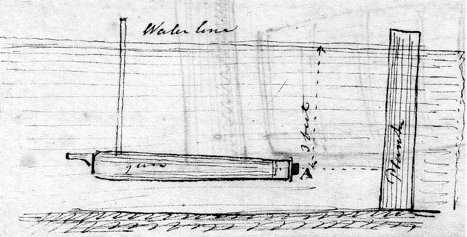
When the gun is loaded as usual, a tompkin or plug is put in the muzle to keep the water out of the barrel as at A,
In this experiment the gun being immerced with the pressure of three feet of water on all its parts. that circumstance might be assigned as a reason for its not bursting; It then became necessary to try the effect with the muzle in water and the britch in air
Second experiment
I procured a common wine pipe and inserted the gun, loaded as before, into one end near the bottom, the muzle in the wine pipe 6 inches, the Britch out 18 inches the pipe was then filled with water to the bunghole, having a head of water of 2 feet 3 inches above the gun, and a body of water6 three feet long through which the bullet had to pass, I then placed the opposite end of the pipe against a yellow pine post, in such manner that if the ball went through the water and pipe it should enter the post, I fired the ball passed through the three feet of water, the end of the pipe and 7 Inches into the post, the cask was blown to pieces the gun not injured.—
Figure 2
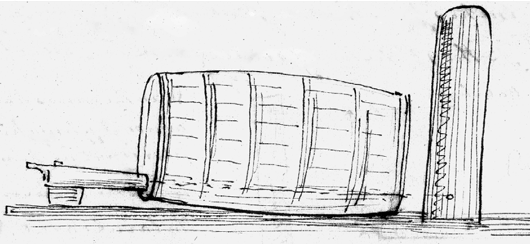
Third Experiment
I obtained a cannon, a 4 pounder for which I cast a lead ball that weighed 6 pounds two ounces the Charge 1½ pounds of powder I placed it under water 4 feet fired at a target distant 12 feet the ball passed7 through the 12 feet of water, and a yellow pine log 15 inches thick the gun not injured.
Fourth experiment
I Put an air box round the same cannon, except one foot of the muzle, so that the muzle might be in water the Britch in air then let it under water 4 feet and fired as before through 12 feet of water and 15 inches of yellow pine gun not injured;
Figure 3
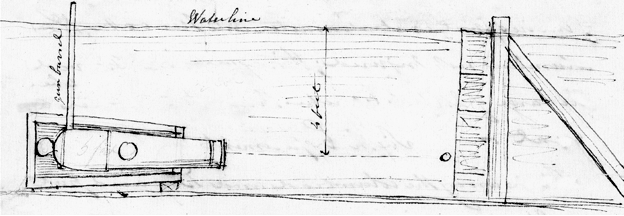
Fifth Experiment
I ordered a frame to be made of two pine logs each 13 inches Square 45 feet long, on one end of which I placed a Columbiad carrying a ball 9 inches diameter 100 pounds weight on the other end I erected a target 6 feet square three feet thick of seasoned sound oak. braced and bolted very Strong thus
figure 4h

The Columbiad except two feet of the muzle was in an air box, the muzle 24 feet 6 inches from the target, the Charge of powder 10 pounds, when fired the ball entered only 9 inches; That is its diameter into the oak; the columbiad not Injured; this experiment proved the range of 24 feet 6 inches through the water to be too great.—
Sixth Experiment
I took away the columbiad and Box and put a 24 pounder in its place loaded with 9 pounds of powder, the muzle 22 feet from the target on firing it entered the target only its diameter that is about 6 Inches; Without mathematical experience the conclusion would have been that the 24 pounder having a quantity of powder equal to near8 one half the weight of the ball, and the Ball 5½ inches diameter presenting little more than one third the resistance to the water and Wood that was presentd by the 9 Inch Ball, it should have intered further into the target9 it did not, momentum was wanting.
Seventh Experiment;
I loaded the Columbiad with 12 pounds of powder and placed the muzle 6 feet from the target the muzle of the gun 2 feet under water the place where the ball struck the target 5 feet under water, in this case the ball went through the target 3 feet thick, and where is not known, the target10 was torn to pieces; In this experiment I fortunately proved11 beyond a doubt, that columbiads can drive balls of one hundred pounds weight through 6 feet of Water and the side of a first12 rate man of war13
On examining doctor Huttons experiments, and theory of projectiles in air, and comparing the density of air with water, the theory is that the columbiad fired, might have been 10 feet from the target, the Ball would then have struck with a velocity of 650 feet a second; and have passed through 3 feet of oak; had the columbiad been 16 feet long and made of a strength to fire with 20 pounds of Powder, the range might have been 15 feet through water. But I will take the medium distance of 10 feet,—And then the14 first undeniable principle is that one Vessel can range alongside of another within ten or 6 or even 5 feet, where giving the Broadside of only two 9 inch balls through the side of the enemy 8 feet below her water line15 the water would rush in with a velocity of 16 feet in a second and Sink her16 in 20 or 30 minutes;17 but from what I have seen in this Sluggish kind of Shot I believe if they were put in about 5 feet from each other, they would destroy timbers between the two points of shock and18 open a Space of many square feet as thus
figure 5

To put this discovery of submarine firing into practice against the enemy I have invented a mode for placing my Columbiads in Ships; from 4 to 8 feet below the waterline as in the following drawing
Figure 6
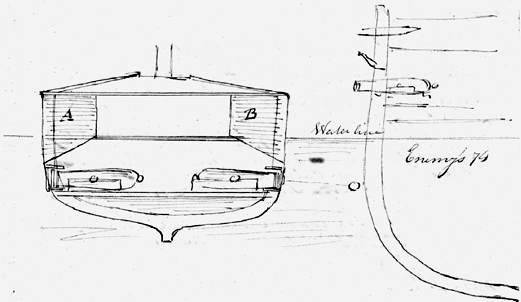
My guns are to be cast with two rims round the muzle thus

The space a, b to be moulded with hemp and covered with thick leather the gun then forms a piston like that of a steam engines,19 or20 the piston of a forcing pump, the gun So prepared there is a Brass cylinder with a strong head cast and boared and bolted in the side of the vessel Whenas in figure 8th21 the gun is run into this cylinder it fits it exactly as
figure 8

the piston does a pump, than if the Caliber of the gun be 9 Inches diameter22 there must23 be a hole through the bottom of the cylinder of 11 inches as at c to let the bullet pass which hole is covered with a strong sliding valve the Axis of which comes inside of the vessel as at D, when the gun is run into the cylinder and ready to be fired the valve openes, On firing the gun recoils shuts the Valve and Stops out the water, thus my guns can be loaded and fired under the water line with near the same ease they are now worked above the water line24 my present Idea is to have 4 Columbiads on each Side of a vessel and two in her Bow So that whether She runs on Bow or Side to the enemy the Bullets must pass through her as in figure 9

you will observe in these sketches that not using guns above the waterline I have no port holes and the sides above the water may be 7 or 8 feet thick of pine logs which renders them not only bullet proof; but the Vessel so Buoyant that She cannot be sunk in this manner my men who worke the guns are out of danger under the waterline and those who steer or work the sails are guarded by walls of wood as A B figure 6th, For harbour defence and perhaps finally for sea service I have combined a Steam engine with this kind of vessel to bring her up to the enemy in a calm or light Breezes; In harbours I would not use masts or rigging, there would be nothing to Shoot away, nor to hold by in case of attempts at boardage, and in such case as my deck would not be wanted for fighting or any other purpose while in action I could make it inclined to 25 degrees, and Slush it So that25 Boarders could not keep26 their feet but must slide into the water they not having a pin or rope to hold by, The steam engine would give a Vessel of this description the means of playing round the Enemy, to take choice of position on her Bow or quarter and with little or no risque sink every thing which came into our waters,
For sea Service27 we must depend more on numbers of which the calculations are28 in favour of my plan,—
A 74 will cost 600,000 dollars and then the 74 of an enemy is equal to her in power, the enemy also have such fleets as will enable them to bring two to one; therefore the chances are against us, For 600,000 dollars I can build 7 Vessels; were they to attack a 74 she could not dismast the whole of them, some one must get within the range of 8 or 10 feet of her where29 one fire from any one of them would certainly destroy her This changes the chances [to]30 Seven to one31 In our favour and Against the enemy for the same capital expended—
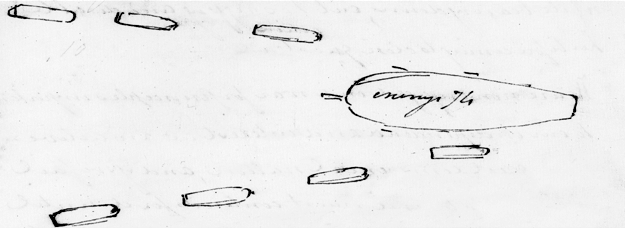
This represents the 7 vessels bearing down on an Enemy here it is obvious that She cannot bring her guns to bear on more than one or two of them, if She lies too to fight they must surround her, But if she sails better than any of them and32 runs away our object is gained for them She can be driven off the ocean into port. As columbiads of 9 inch caliber are tremendious engines for close quarters I could have 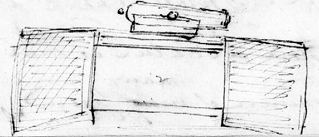 two on pivots and Circular carriages within my wooden walls as thus which being loaded with semi Shot and chains 20 feet long would at 200 yards distance while bearing down, cut her rigging and disable her before coming to close action;—
two on pivots and Circular carriages within my wooden walls as thus which being loaded with semi Shot and chains 20 feet long would at 200 yards distance while bearing down, cut her rigging and disable her before coming to close action;—
We are now engaged in a war for principles important to our independence and interest as an active and great commercial nation, and if we fail generations to come must contend for it until they suceed; at all events millions must be expended, which if33 as successful as our present hope; will fall far short of the liberty of the34 seas, In expectation35 to discover in the consealed magazines of science some36 certain mode for destroying military navies, and thereby establishing a perfect liberty of the seas I have laboured at intervals with much ardor for 13 years, I now submit to your reflections whether I have found it, My present impression—and commodore Decatur is that I have this is also the opinion of many friends for you will consider that if those Vessels can destroy such as now exist they cannot be used against each other without both parties going to the bottom and such war cannot be made as duels would never be fought if both parties were obliged to Sit on a cask of powder and ignite it with quick match.37
2 millions of dollars would build 20 Such Vessels 60 men to each would be sufficient total 1200 men. Such a fleet would clear our coast, and the probability is it would be the most powerful fleet in the world;—one however should be built by government to establish principles in the public mind which are38 already proved in private39—On the whole of this subject after you have maturely reflected It will give me great pleasure to have your opinion—and if it coinsides with mine, your influence at washington may be necessary to carry it into effect, I Sincerely hope this new art may give many pleasing hours to Your evening of life, as this wish is from the heart it is better than the usual unmeaning40 compliments with which letters are concluded—
Robt Fulton
Dft (PPAmP: Thomas Jefferson Papers); bracket in original; at head of text: “Thomas Jefferson Esqr”; with two later attestations at foot of text: “This document is, I am confident, genuine. R. H. Thurston” and “The foregoing document is in the handwriting of Robert Fulton—with which I am well acquainted. Geo: H. Moore Librarian &ca New York: October 19. 1874”; notation by Fulton on separate sheet: “In 1663 the Marquois of Worcester discovered the power of Steam”; with docket on that sheet in an unidentified hand: “Copy of a Letter to Mr Jefferson on Submarine Guns. This Paper is in the handwriting of that Great Benefactor of his Country Robert Fulton Esq.” Tr (NHi: LeBoeuf Collection); in Fulton’s hand and signed by him; at foot of page: “To Thomas Jefferson June 29 1813”; extract consisting of a copy of figure six. Recorded in SJL as a letter of 29 June received 10 July 1813 from New York. Enclosed in TJ to James Madison, 13 July 1813.
The britch (breech) of a firearm is the part located at the rear of the barrel, while a columbiad is a type of heavy cast-iron cannon or howitzer once used by the United States Army (). doctor Charles Hutton, a professor of mathematics at Great Britain’s Royal Military Academy, was the author of The Force of Fired Gun-Powder, and the Initial Velocities of Cannon Balls, determined by Experiments; From which is also deduced The Relation of the Initial Velocity to the Weight of the Shot and the Quantity of Powder (London, 1778).
1. Reworked from “As every advance in the arts which may be of use to america will give you pleasure, I.”
2. Fulton here canceled “just.”
3. Word interlined in place of “much.”
4. Word interlined in place of “complete.”
5. Omitted closing bracket editorially supplied.
6. Preceding four words interlined.
7. Manuscript: “passeed.”
8. Word interlined, with an illegible word interlined and canceled above it.
9. Preceding three words interlined in place of “than the latter.”
10. Word interlined in place of “whole thing.”
11. Preceding six words interlined in place of “here then it is proved.”
12. Manuscript: “frst.”
13. Preceding six words interlined in place of “any vessel of War.”
14. Manuscript: “The the.”
15. Word interlined in place of “line, it will drive in her side at least two holes nine inches diameter each into which the.”
16. Reworked from “and she must Sink.”
17. Manuscript: “minuets.”
18. Preceding nine words interlined in place of “drive in the space between them and.”
19. Reworked from “those of our steam engines.” In making this revision, Fulton neglected to cancel the “s” in “engines.”
20. Fulton here canceled “say like.”
21. Preceding four words interlined.
22. Word interlined.
23. Word interlined in place of “is to.”
24. Preceding thirteen words interlined.
25. Preceding two words interlined in place of “well.”
26. Draft here consists of two versions of the remainder of this and the whole of the following two paragraphs. Fulton heavily reworked the initial version, then canceled it and copied it with minor variations onto a separate sheet. This latter formulation is used here.
27. Initial version used “operations” instead of this word.
28. In initial version Fulton here canceled “all.”
29. Manuscript: “were.”
30. Omitted word editorially supplied.
31. Reworked in initial version from “here the chances are 100 to 1 against” to “Consequently the chances are changed 7 to one.”
32. Manuscript: “an.”
33. Fulton here canceled “even.”
34. Manuscript: “they.”
35. Word interlined in place of “hope.”
36. Fulton here canceled “new.”
37. Preceding two words interlined in place of “a red hot Iron.”
38. Preceding six words interlined.
39. Preceding two words interlined.
40. Word interlined.
Index Entries
- artillery; columbiads search
- artillery; underwater search
- boats; steamboats search
- Decatur, Stephen; and R. Fulton’s underwater cannon search
- Fulton, Robert; and steamboats search
- Fulton, Robert; and torpedo search
- Fulton, Robert; and underwater cannon search
- Fulton, Robert; letters from search
- Hutton, Charles; and velocity of fired cannonballs search
- machines; cannon, underwater search
- machines; torpedo (mine) search
- torpedo (mine) search
- Worcester, Edward Somerset, marquis of; inventor of steam engine search

![University of Virginia Press [link will open in a new window] University of Virginia Press](/lib/media/rotunda-white-on-blue.png)
